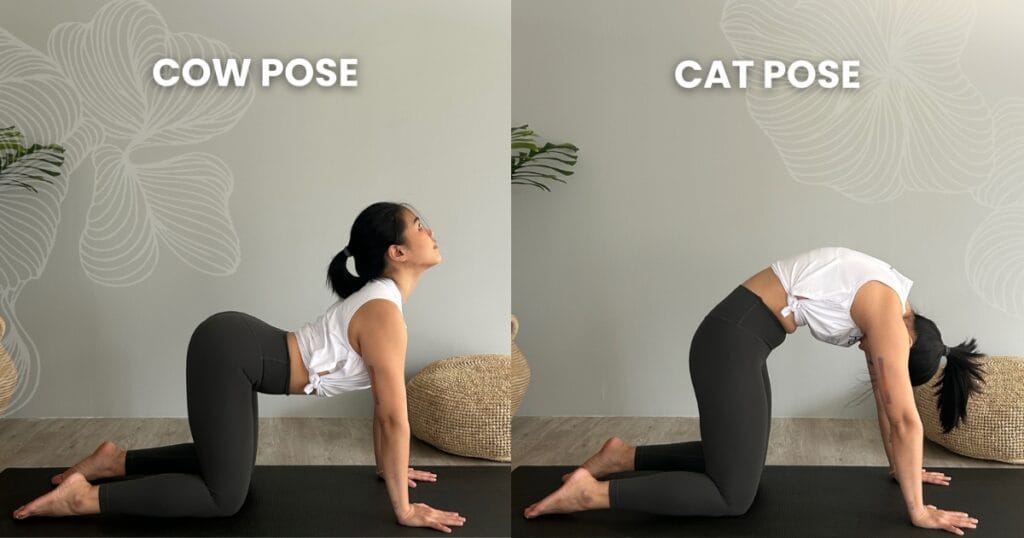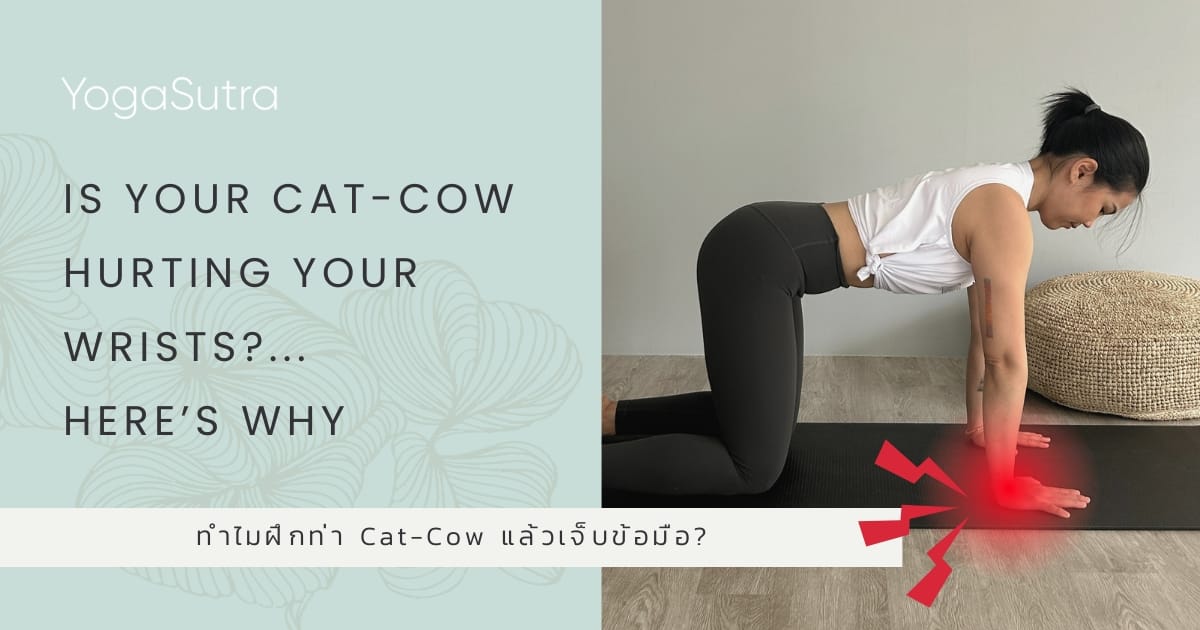It’s a common challenge many people face in their yoga practice: wrist pain. While the Cat-Cow (Marjaryasana-Bitilasana) sequence is a fantastic way to warm up the spine, dealing with wrist pain can quickly take the joy out of this fundamental pose.
So, what causes this discomfort, and how can you find relief? Let’s explore the main reasons and practical solutions.
Common Causes of Wrist Pain in Cat-Cow
1. Alignment & Weight Distribution
Cat-Cow may look simple, but proper alignment and balanced weight distribution are essential to avoid wrist pain.
- Spread Your Weight Evenly: Don’t let all the pressure fall on the heel of your hands. Instead, press down through the entire palm, especially the base of your index finger and thumb, to distribute weight evenly.
- Stack Your Shoulders: Keep your shoulders directly over your wrists. If your shoulders lean too far forward or back, unnecessary strain goes straight into the wrists.
- Micro-Bend the Elbows: Avoid hyperextending or locking your elbows. A gentle bend lets your muscles (not your joints) support the posture.
- Engage Core & Shoulders: Activate your core muscles and shoulders to share the workload, so your wrists aren’t bearing all the pressure.
By combining mindful alignment with even weight distribution, you’ll protect your wrists and build a stronger, safer Cat-Cow foundation.
2. Weak or Tight Wrists
Limited flexibility or lack of wrist strength makes it difficult for the joints to handle prolonged pressure.
The wrists are relatively small joints compared to the weight they often support during yoga poses like Cat-Cow, Plank, or Downward Dog. When the wrists are weak, the supporting muscles around the forearm and hand cannot fully stabilize the joint, causing the bones and ligaments to absorb more pressure than they should.
On the other hand, if the wrists are tight due to limited flexibility, the joint may not be able to extend comfortably at a 90-degree angle, which is common in Cat-Cow. This combination of weakness and stiffness increases strain, leading to pain or discomfort.
3. Previous Wrist Injuries
If you have a history of wrist issues such as tendonitis, sprains, or carpal tunnel syndrome, you may experience discomfort when placing weight on your hands. These conditions can make the wrist more sensitive to pressure and repetitive extension, as required in Cat-Cow. Even mild flare-ups may limit mobility and stability, leading to pain.

How to Protect and Modify Cat-Cow for Wrist Safety
You don’t need to give up Cat-Cow; the key is to adjust your practice and learn how to protect your wrists.
1. Distribute Weight Properly
Spread your weight evenly across the palms, especially at the base of the index fingers and thumbs, instead of dumping it all on the heels of your hands. Engage your core and shoulders so that your wrists aren’t taking all the pressure, and keep a micro-bend in your elbows to avoid locking the joints.
2. Adjust Hand Position
- Claw the Mat: Actively press into your fingertips, creating a “claw” shape to lift some of the load off your wrists.
- Make Fists: If pain is severe, place your knuckles down instead of your palms for a neutral wrist angle.
- Forearm Option: Practice Cat-Cow on your forearms when needed to fully relieve the wrists.
3. Use Props for Support
Place a rolled-up towel, wedge, or yoga blocks under the palms to reduce wrist extension. This small adjustment can provide significant relief.
4. Strengthen and Stretch the Wrists
Incorporate warm-ups like wrist rolls, flexion/extension stretches, or tabletop wrist drills before class. Build strength gradually with forearm planks or Dolphin Pose, which shift effort into the shoulders and forearms.
5. Listen to Your Body
Never push through sharp pain. Modify when needed and consult your instructor for safe alternatives or adjustments tailored to your body.
Wrist pain is a common part of the journey for many new and even experienced yogis. By applying these simple tips, you can find a way to make Cat-Cow and other poses feel good again.
If you have any further questions or need personalized guidance, feel free to speak with our instructors at YogaSutra.
ท่า Cat-Cow (Marjaryasana–Bitilasana) เป็นท่าโยคะพื้นฐานที่ช่วยคลายตัวและเคลื่อนไหวกระดูกสันหลัง แต่หลายคนอาจรู้สึกเจ็บข้อมือเมื่อทำท่านี้ สาเหตุหลักมักมาจากการลงน้ำหนักที่ข้อมือมากเกินไป ข้อมือยังไม่แข็งแรงหรือยืดหยุ่นพอ รวมถึงการจัดท่าที่ไม่ถูกต้อง เช่น ไม่กางนิ้วมือ หรือวางข้อมือไม่ตรงกับหัวไหล่ นอกจากนี้ หากมีอาการบาดเจ็บเดิม เช่น ข้อมืออักเสบ อาจทำให้รู้สึกเจ็บมากขึ้น
เพื่อแก้ไข ควรกระจายน้ำหนักตัวให้สมดุลโดยใช้กล้ามเนื้อแกนกลาง ไม่ทิ้งแรงทั้งหมดลงที่ข้อมือ พร้อมใช้อุปกรณ์ช่วย เช่น บล็อกหรือผ้ารองข้อมือ รวมถึงฝึกเสริมความแข็งแรงและยืดเหยียดข้อมือ เช่น การหมุนข้อมือ หรือการทำ Tabletop Wrist Conditioning หากยังเจ็บ สามารถปรับเป็นการวางท่อนแขนลงแทนมือได้
การฝึกอย่างถูกวิธีและฟังเสียงร่างกายเป็นสิ่งสำคัญ หากเจ็บเฉียบพลันควรหยุดพัก และหากมีอาการเรื้อรังควรปรึกษาครูโยคะหรือแพทย์ การปรับท่าอย่างเหมาะสมจะช่วยให้คุณฝึก Cat-Cow ได้ปลอดภัย ได้ประโยชน์เต็มที่ ทั้งการคลายเครียด เพิ่มความยืดหยุ่น และเตรียมร่างกายเข้าสู่การฝึกที่ลึกขึ้น
